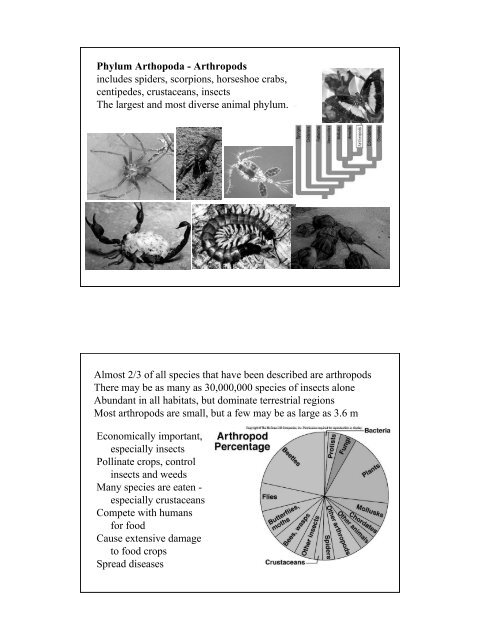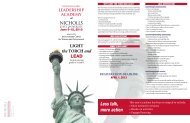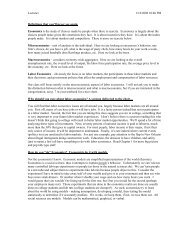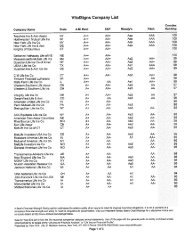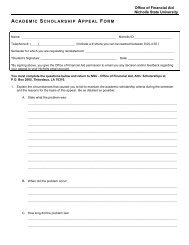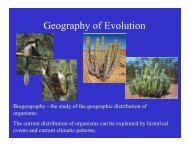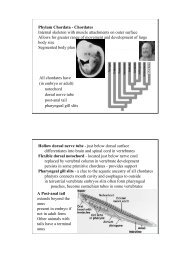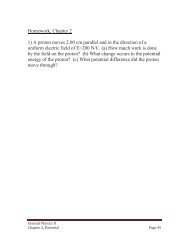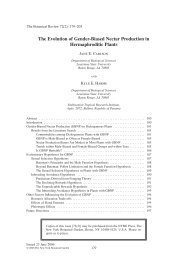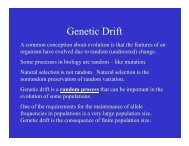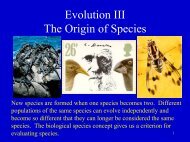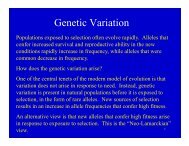Animal Diversity 4-2.pdf
Animal Diversity 4-2.pdf
Animal Diversity 4-2.pdf
Create successful ePaper yourself
Turn your PDF publications into a flip-book with our unique Google optimized e-Paper software.
Phylum Arthopoda - Arthropodsincludes spiders, scorpions, horseshoe crabs,centipedes, crustaceans, insectsThe largest and most diverse animal phylum.Almost 2/3 of all species that have been described are arthropodsThere may be as many as 30,000,000 species of insects aloneAbundant in all habitats, but dominate terrestrial regionsMost arthropods are small, but a few may be as large as 3.6 mEconomically important,especially insectsPollinate crops, controlinsects and weedsMany species are eaten -especially crustaceansCompete with humansfor foodCause extensive damageto food cropsSpread diseases
Key Innovations of Arthropods: Jointed appendages, completeexoskeleton, segmental body with specialization of body regionsArthropod means "jointed feet"Jointed appendages arespecialized for differentfunctions: legs, mouthparts,antennaeJoints in appendages makethem highly functional forwalking, and graspingAntennae are sensory -sounds and chemicalsMouth parts specialized fordifferent food sourcesRigid exoskeleton, made of chitin and protein helps to protectagainst predators and reduces water loss - allows life in dryenvironmentsSkeleton functions as attachment for musclesmuscles attach to interior of skeletonExoskeleton limits arthropods maximum sizealthough chitin is tough, it is brittle and cannot support greatweight without increasing its thickness greatlyExoskeleton must be shed in order for increase in size - “ecdysis”
Segmental body plan clear in all forms, but segments oftenfused to form specialized body regions - “tagmats”Insect: head, thorax, abdomenCrustacean: cephalothorax, abdomenLiving arthropods divided into three subphyla - based on appendagesChelicerata:first appendages are forfeeding - chelicerae -fangs of spidersfeeding appendages ofhorseshoe crabsCrustacea and Uniramia (Tracheata) together called theMandibulates: first appendages are antennae, first feedingappendages are called mandibles
Mandibulates are divided into two subphyla - Crustaceans andUniramians (Tracheata) - based on appendagesCrustaceans have biramous (branched) appendagesUniramians (insects, millipedes, centipedes) have uniramous(unbranched) appendagesGeneral Biology of ArthropodsExoskeletonAll arthropods covered by hardened exoskeletonmade of chitin and protein - secreted by and fused withepidermisvaries in toughness and thicknessmany crustaceans add calcium carbonate - increases rigidityFunctions of exoskeletonprevents excessive water lossprotects from predators and injuryMolting - a liability of the exoskeletonGrowth requires periodic ecdysis, shedding of outer cuticleNew exoskeleton grows beneath old oneSeparated by a fluid that dissolves components of old skeletonOld skeleton cracks open and is shedNew skeleton is soft and must be expanded to full sizeHardens with exposure to air or water
A new exoskeletonforms inside old -old one must beshed - “ecdysis”The newexoskeleton and allof the body parts itencloses must bepulled out of oldexoskeleton -includes legs,claws, gills, etc.Each new lifestage is called an“instar”EyesOcelli are simple eyes with single lensesSometimes occur together with compound eyesFunction in distinguishing light and darkCompound eyesComposed of many ommatidia - independent unitsEach covered with a lens - contains eightretinular cells and central light-sensitive rhabdomEach ommatidium receives its ownimage and is connected to a nervecell - entire image is integrated inthe brain
Gut is tubular and extends from mouth to anus - with specializedregions - crop, stomach (midgut), hindgut, intestine, rectumCirculatory System is openheart extends throughthorax and abdomencontraction sends bloodforwardrelaxation draws bloodfrom tissuesone-way valves in heartallows blood to flowforward onlyblood from anterior endflows through tissues toposterior endRespiratory SystemCrustaceans have feathery gills under carapaceChelicerates have book gills and book lungs - series of plates withthin respiratory epithelium
Terrestrial Uniramians and some Chelicerates have trachaeaTrachea are branched tubules that allow air to diffuse into the bodysmaller tracheoles bring air to individual cellsair entry controlled through external spiraclesclosing spiracles conserves waterflow is mostly passive - muscular movements can increase flowlimits body size because all cells must be able receive oxygenExcretory SystemSeveral forms of excretory systemsTerrestrial Uniramians have Malpighian tubulesSlender tubular projections off the digestive tract at thejunction of the midgut and hindgutWater and solutes pass through walls of tubulesnitrogenous wastes are precipitated as uric acid or guanineFluid with waste is emptied into hindgut and eliminatedMost water and valuable solutes reabsorbed by hindgutAn efficient systemthat conserves water- a good adaptationfor terrestrial life
Nervous SystemDouble chain of ganglia runs along ventral surfaceThree fused pairs of dorsal ganglia form the brainventral ganglia control local activity of body regionsmany activities continue with brain removedBrain appears to be inhibitor, not stimulator (as in vertebrates)some activities begin spontaneously when head is removedThree Classes of CheliceratesClass Arachnida - spiders, scorpions, ticksClass Merostomata - horseshoe crabsClass Pycnogonida - sea spiders
Class Arachnida - ArachnidsLargest class of chelicerates includes spiders, daddy longlegs,scorpions, mites & ticksAll have a pair of chelicerae, pair of pedipalps, four pairs of legsChelicerae are first appendages, fangs with poison glandsPedipalps are next, similar to legs - rarely used for locomotionoften used for catching and handling preymay also chew with basal portionmay function as copulatory organs orsensory organsscorpion pincers are pedipalpsMost are carnivorous, some mites are herbivorousMost ingest only liquified foods, digestion begins externallyMost are terrestrial, direct transfer of sperm for reproductionRespire with trachea, book lungs or bothClass Merostomata - Horseshoe CrabsExample: Limulus, common on North Atlantic coastsAncient group, Limulus fossils date to 220 million years oldLive in deep water, migrate to shallow coastal waters to mateFeed at night on mollusks and annelidsShell-like carapace over cephalothorax protects most body partsSwim with carapace down moving abdominal platesPossess four pairs of walking legs, chelicerae, and pedipalpsRespire via five pairs of book gills
Class Pycnogonida - Sea SpidersCommon in marine habitats, especially in cool watersrarely observed because of small sizeNot closely related to spidersAdults are parasites or predators on other animalsHave sucking proboscis with terminal mouthBody consists mostly of cephalothorax, no well-defined headPossess four to six pairs of legsMales exhibit parental care of young,carry eggs on legsSubphylum Crustacea - Crustaceansincludes shrimp, crabs, crawfish, lobsters, pillbugs, copepods,brine shrimp, barnacleshave biramous (two branch) appendages, two pairs of antennae,and 3 pairs of feeding appendages,larger forms have feathery gills near base of legsMost have a nauplius larva
Have legs on thorax and abdomen like millipedes and centipedesbut unlike insectsHaving two pairs of antennae is unique to crustaceansMany have compound eyesHave tactile (touch sensitive) hairs over whole bodyExcretion of nitrogen wastes occurs mostly across surface of cuticleVariety of sexual styles and care of youngCrustacean <strong>Diversity</strong>Decapod ("ten-footed") Crustaceans -includes lobsters, shrimp, crabs, crawfishExoskeleton reinforced with calcium carbonateAnterior segments fused into cephalothorax, covered by carapaceCrushing pincers common, used to obtain food and in defenseSwimmeretsused inreproduction andlocomotionSnapping oftelson anduropods causesforceful, rapidmovement to therear
Crustaceans <strong>Diversity</strong>Terrestrial forms - pillbugs, sowbugs, isopodsAmphipods are both terrestrial and aquaticPlanktonic crustaceansCopepods (Copepoda)Water fleas (Cladocera)Ostracods (Ostracoda)Fairy shrimp and brine shrimp (Anostracoda)Sessile CrustaceansInclude barnacles (Cirripedia)Sessile adults, free-swimming larvaeHead attaches to substrate, food sweptinto mouth by feathery legshave shell-like plates covering bodySubphylum Uniramia (or Tracheata) - has three classesClass Chilopoda - centipedesClass Diplopoda - millipedesClass Insecta - insectsWell adapted to terrestrial lifeRespire with tracheaMalpighian tubules for excretionWaxy cuticle on exoskeleton
Centipedes and Millipedes - both have head tagmat followed bynumerous repeating segments - each with paired appendagesCentipedes (hundred legs) have one pair of legs per segmentMillipedes (thousand legs) have two pairs of legs per segmentCentipedes - carnivorous, most eat insectsAppendages of first body segment are poisonous fangsMillipedes - most are herbivorousCan roll bodies into a flat coilMay secrete defensive fluids and cyanide gasReproduction similar in both groupsSexes separate, fertilization is internal, copulate totransfer sperm, all species lay eggsJuveniles are similar to adults in appearanceClass Insecta - InsectsLargest group of organisms on earth - with great diversityEspecially numerous in the tropics
Most are terrestrial but many are aquatic in freshwaterHave three body segments: Head, thorax, abdomenHave three pairs of legs, all attached to thoraxHave one pair of antennaeMay have one or two pairs of wingsSexes separate with internal fertilizationWings arise as sack-likeoutgrowthsWings are solid exceptfor veinsWings are nothomologous to otherappendagesDigestive tract is tubular and slightly coileddigestion occurs within stomach or midgutExcretion by Malpighian tubulesRespiration via trachea that extend throughout bodymay have air sacs with muscles that create a bellows systemto allow deeper air circulation in bodySpiracles can be closed by muscles to retard water loss
Possess wide variety of sensory systems - in addition to eyesSensory hairs located all over bodies especially on legs andantennaeSounds detected by tympanumSensory hairs may also detect sound wavesProduce sounds which may inaudible to humansChemicals (pheromones) are also used tocommunicateDevelopmentMost insects hatch from laid eggs - rarely develop within motherAfter hatching young insects undergo regular ecdysis through aseries of instarsOften the larva is very different from the adult and undergoesmetamorphosis to become adultIn simple metamorphosis, wings develop during juvenile stagethere is no "resting stage" before last moltImmature stages are called “nymphs”Seen in beetles, grasshoppers, dragonflies, cockroaches, silverfishSimple Metamorphosis
In complete metamorphosis, wings develop during a restingstage just prior to final moltresting stage called a pupa or chrysalis - at this time cellularreorganization occurs to form adult bodyPupa does not normally move, except in mosquitoesCompleteMetamorphosisJuveniles and adults live in distinct habitats -larvae often worm-like, lacking large eyes, and legsLarvae usually have chewing mouth-parts, even if adults havesucking mouth-partsPupae are usually inactive and do not feedseen in moths, butterflies, beetles, bees, wasps, ants, flies, fleas


